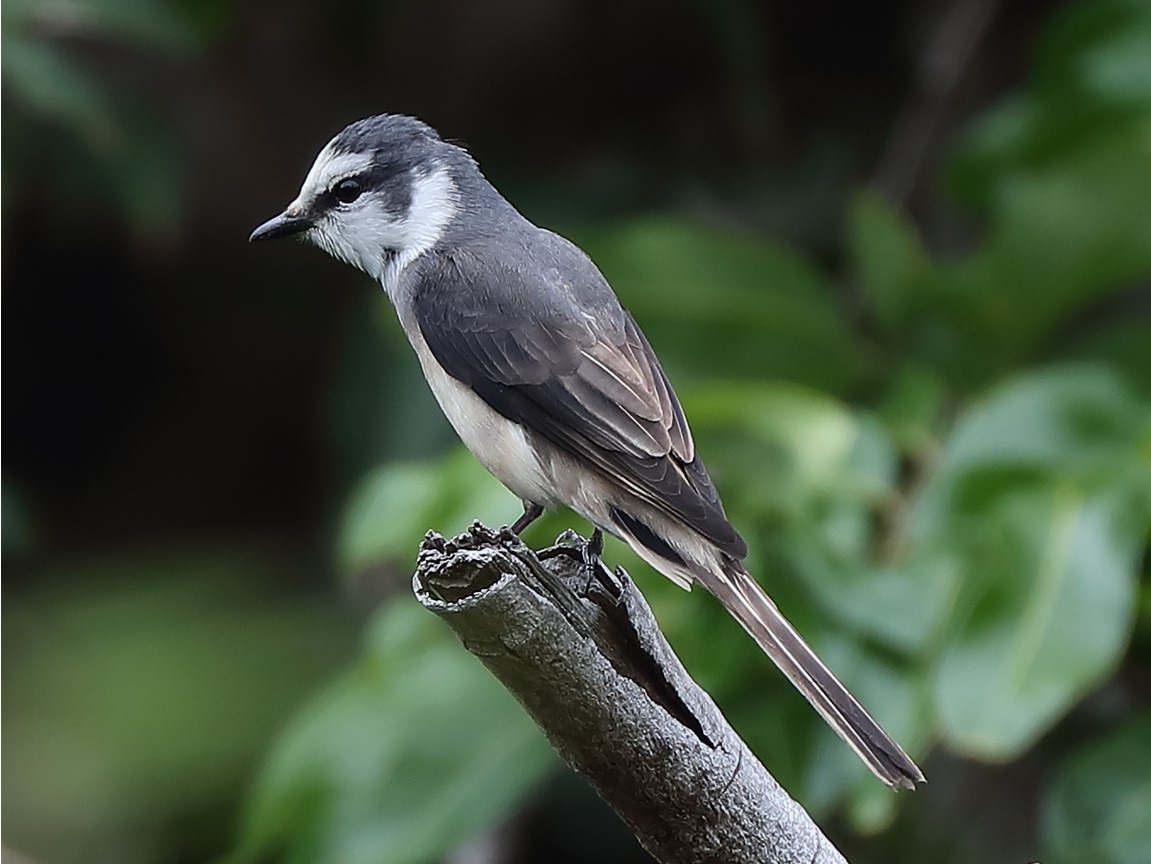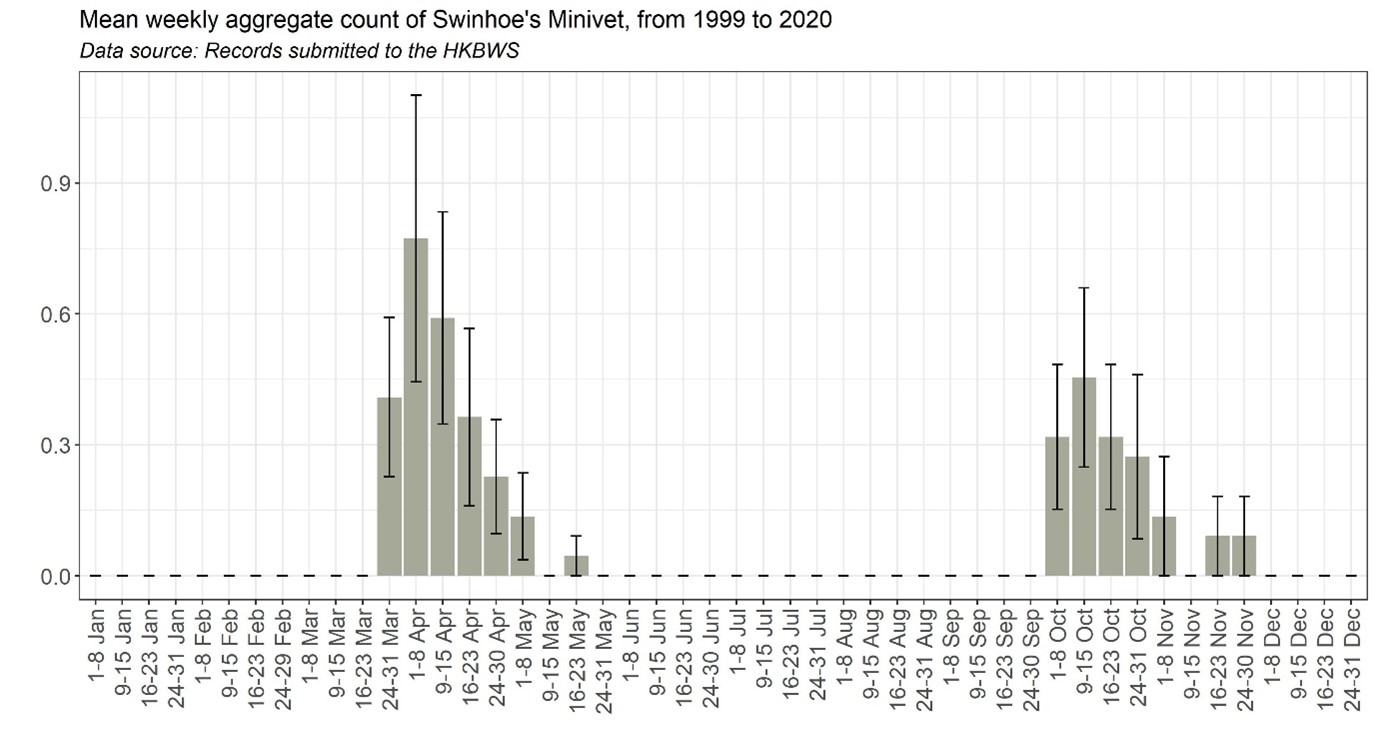Swinhoe's Minivet Pericrocotus cantonensis 小灰山椒鳥
Category I. Scarce passage migrant that occurs in wooded habitats.
IDENTIFICATION

Apr. 2018, Michelle and Peter Wong. Male.
18-19 cm. Grey minivet similar to Ashy but paler and browner with a pale rump, dingy breast and flanks and less contrasting tail.
Male is grey from mid crown to mantle, has a white forehead and broad black eye stripe from bill base and has white underparts. Distinguished from male Ashy by lack of pure black in crown and nape, obvious extension of white forehead behind the eye and rounded grey bulge that falls onto face from behind the eye.

May 2019, Guizhou, China. James Kennerley. Female.
Females are pale grey with a pale rump and, compared to males, a less obvious extension of the pale supercilium behind the eye (sometimes absent). The downward bulge behind the eye is likewise variable. On both sexes the upperparts are brown-tinged (more so on female), the underparts washed very pale buff, the rump is dull brownish and the shafts of the rectrices are whitish.

Apr. 2006, Matthew Kwan. Second calendar-year.
First-winter birds are similar to adult female but duller with less marked head pattern and sometimes indistinct barring on flanks.
VOCALISATIONS
The typical call is a rapid trill that is higher in pitch and thinner than that of Ashy Minivet.
DISTRIBUTION & HABITAT PREFERENCE
Most records are from offshore islands, occasionally the central and northwest New Territories. Most frequently seen on Po Toi, but also recorded elsewhere, such as Lam Tsuen Valley, Mai Po, Tai Po Kau and Shek Kong.
OCCURRENCE
In spring, Swinhoe’s Minivet occurs from the last week of March to the third week of May, peaking in the first half of April (Figure 1). Apart from a female at Lam Tsuen on 27 February 2019, extreme dates are 25 March 2016 and 2017 and 6 May 2019. Most records concern one to three birds, which are occasionally seen with Ashy Minivets. The highest count was of up to 13 at Mai Po NR during 1-8 October 1998, followed by six at Tsim Bei Tsui on 8 April 1985.
Autumn passage is not as strong as that in spring and occurs mainly in October, with an apparent peak in the second week. Extreme dates are 1 October 1998 and 25 November 2013 (the next earliest occurred on 31 October 2015). While 83.3% of the spring records are from Po Toi, birds on autumn passage are much less likely there (only 6.8%).
Swinhoe’s Minivet was first recorded on 30 March 1968 at Stanley Cemetery. Subsequently there were only seven records up to 1999, probably due to a lack of familiarity with its appearance. Since 2009, however, it has been recorded annually, though numbers are somewhat variable.
BEHAVIOUR, FORAGING & DIET
Occurs mostly singly but sometimes in small flocks of two or three, occasionally together with Ashy Minivet. No local observations regarding diet but it presumably feeds on a wide variety of invertebrates as do other minivet species.
RANGE & SYSTEMATICS
Monotypic. Breeds in south China from Gansu and Shaanxi east to south Jiangsu, south Guizhou, Guangxi, Guangdong and Fujian; winters in southwest China (Yunnan), Myanmar, Thailand, Laos, Cambodia and Vietnam (Taylor 2020).
CONSERVATION STATUS
IUCN: Least Concern. Population trend decreasing.
Figure 1.

Liu, Y. and Y. H. Chen (eds) (2020). The CNG Field Guide to the Birds of China (in Chinese). Hunan Science and Technology Publication House, Changsha.
Taylor, B. (2020). Brown-rumped Minivet (Pericrocotus cantonensis), version 1.0. In Birds of the World (J. del Hoyo, A. Elliott, J. Sargatal, D. A. Christie, and E. de Juana, Editors). Cornell Lab of Ornithology, Ithaca, NY, USA. https://doi.org/10.2173/bow.brrmin1.01

